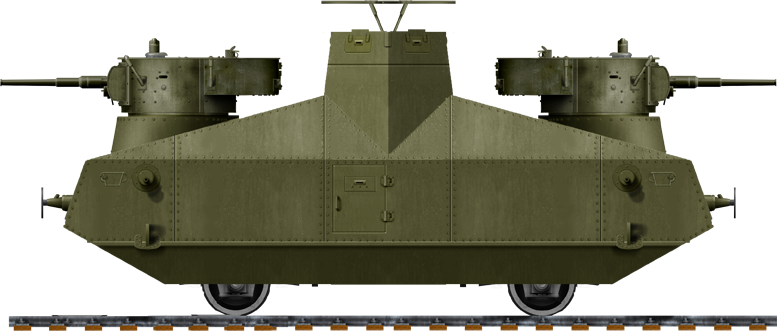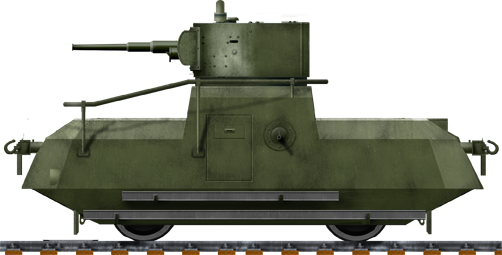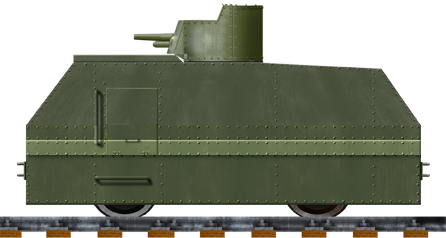Soviet Armored Self-Propelled Railroad Cars
 URSS - Railroad Cars c150 built 1932-44
URSS - Railroad Cars c150 built 1932-44
 D-3 Draisina (1934)
D-3 Draisina (1934)

The D-3 armored draisine was a self-propelled, armored railcar built by for Soviet in the interwar, up to the summer of 1941. The D-3 was developed from 1932 to fill the needs of the Red Army for a mass-produced, heavily armed patrol railcar. To make it affordable, as many of already existing and proven elements were used. The armament consisted in two T-26 tank model 1933 and its engine, coupled with the D-35 gearbox. The armor was sloped and ranged was from 10 to 16 mm. The commander's position was located in the central observation turret, with four armoured shutters and a large hatch. The radio set was also located there, as well as a bedframe antenna. The gasoline engine was rated for 93 HP. Apart the standard 45mm guns, both turrets had a coaxial DT machine gun.
There were an additional four 7.62mm Maxim machine guns placed in the hull, protruding from ball mounts on either sides. Access to the draisine was from two side doors. The crew comprised six men for the turrets, four more gunners, a commander and a radio, a total of 16 max, 11 in reduced crew mode. The D-3 draisine patrolled the borders of the USSR. It had been designed to operate eindependently or as part of an armored train, with pneumatic connections. The D-3 took part in the initial German-Soviet war invasion phase, in which most were lost. The survivors went on in combat until 1945.
 D-37 Draisina (1932)
D-37 Draisina (1932)

The D-37 type Draisine appeared as one of the first dedicated interwar Red army railway car. Designed in 1932 it sported the D-38 turret equipped with up to two DT machine guns (coax and turret back), and a 76 mm short barrel model 1927 gun, for railroad protection and scout for armoured trains. It was made with an uni-body with well sloped angular plates, welded together, and 12 mm (0.5 in) fore and aft and on the sides, 6mm (0.28 in) elsewhere.
It was powered by a 40hp licence-made Ford engine located in the lower part of the hull, with the fighting station above. In addition to the turret there were two more DT MGs in ball mounts close to the only access doors. It seems an AA station with twin Maxim machine guns was also located in the rear hull, covered by a two piece hatch. It was open when needed and the mount manually raised. The D-37 in the end never entered production, remaining a test bed for for the DT-45 Draisine, notably found underpowered.
They had still special devices fore and aft that were kept for future models. This helped to rapidly swap tracks when parallel if available, or going on damaged tracks, or just free the tracks for passage of another train. This consisted in a leaf spring blocking system, two jacks, two pair of beams to be joined together making a full rail section. The leaf springs allowed wheels to lift together with the vehicle, the railcar was hoisted using the two jacks up to a level where the wheel flanges were clear of the rails, and pivoted on the transfer beams when assembled, placed on rails, fixed to them with special brackets and joined with spacers.
Two small casters each end prevented the wheels to roll over. When done, the railcar was simply pushed onto the nearby track or aside with the 4 men of the crew and/or a winch of at least 500kgs pulling capacity, tied to a nearby telegraph pole or equivalent. The beam pairs wa spresent on the car sides with its brackets and remaining equipment carried inside the hull.
 DT-45 Draisina (1933)
DT-45 Draisina (1933)

The DT-45 was a development of the D-37 in 1933, modernized for railroad track protection as well as a scout car for armoured trains. The new railroad vehicle shared the same armoured hull and powerplant as the D-37 (40 hp Ford initially, later probably 50 hp) in the hull's ball mounts, close to the small entry doors. The turret was a midified version of the BT-26 light tank, with a 45 mm 20-K main gun and coaxial 7.62mm DT machine gun. It was also given a horseshoe bedframe antenna attached around the hull, connected to a 71KT radio and permanent operator for a crew of 7: 2 drivers (fore and aft), one commander and gunner in the turret and two MG gunners. Like the D-37 it did not entered mass production, and the few built to improve over the 1932 D-37 Draisine were used for training draisine crews in 1940.
 BD-41 (1942)
BD-41 (1942)

The BD-41 armoured self-propelled railroad car was designed and made between December 1941 and January 1942 in Moskow at Voitovitch plant. The hull was welded from 8-10 mm armoured plates, placed on a chassis of a local auto-section railway car. It was given a standard T-26 model 1931 dual turret, armed with a 37mm and coaxial 7.62 mm, on top of the hull. It was powered by a gasoline front-mounted engine which exhausted both forward of the turret and on the left side, while the crew entered by the side right door. There were seats and ammunition storage for 4-6 men, including two to man the turret, and assistant and a railcar officer. A few DB-41 were manufactured for testing, siverging in some points, at the plant, before swapping to a more advanced model. These were transferred to the 7th separate batallion of armoured trains for trials but not adopted for mass production. Instead, the few prototypes went on to serve in 1942-44 operations until their loss. Note: Future dedicated article on all these different soviet railroad cars planned.
 MBV-2 (1938)
MBV-2 (1938)

The MBV-2 was the heaviest WW2 self-propelled armoured carriage. Two were made by the Kirov Factory in 1938, armed each with six machine guns and three T-28 tank turrets. They were rearmed during the war with L-11 for one, and F-34 for the other, from the T-34/76 of the 1940 and 1942 types. They served with the Leningrad Front, 14th Independent Armored Train Battalion. One is now preserved at Kubinka.
 Krasnaja Zvezda (1942)
Krasnaja Zvezda (1942)

Work on creating armored trains or draisines using tank elements (mostly turrets) started in USSR in the early 1930s. So, over the course of several years, the D-37, DT-45, BD-39 railcars appeared on the basis of a standard M 3/2 motor vehicles mass-produced by the Kaluga plant and with T-26 tank turrets. However between their low engine power (40 hp) and weak armor (9-15 mm) they failed to effectively solve their assigned combat missions. Therefore, they were not widely used and not mass-produced. Indeed by June 22, 1941 during Operation Barbarossa, only nine were available with the Red Army.
In December 1941, Kolomna Locomotive Plant (V. Kuibyshev plant) or rather, what remained after its evacuation by October 1941 was repairing KV tanks and V-2K diesel engines coming from the frontline. This became the basis for starting a new design of “diesel locomotive with a powerful armor protection and armament”. Work was carried out under the guidance of engineer Lebedyansky, famous steam locomotive designer. Even before the war, on instructions of the Automotive Tank Directorate of the Red Army, he worked on a project for an armored diesel locomotive. Work proceeded very quickly and by February 1942 the final vehicle "Soviet Red Star track motor car" was ready.
The body of of this armoured draisine "Krasnaja Zvezda" consisted of two longitudinal I-beams and a frame made of a L-section beams riveted together, to which armor plates were attached, welded together after being bolted on the frame. The undercarriage comprised two biaxial bogies of same design. Each was equipped with a V-2K engine, one to move forward, and the other backward. So technically it had a total output of c1400 hp (unitary 340–520 kW (460–700 bhp)) could run at the same speed in either direction. Each bogie had the V-2K engine using transmission via a cardan chain, a large fan extracting air from below to cool the engine, and a chassis developed by M. Svirin according to archives.
Thus despite the large armoured structure, estimated to be 13 to 50 mm (face and rear) in thickness, the "Krasnaja Zvezda" was much faster than a KV-1 model 1940 (angular, all welded) only keeping its turret and 76 mm main gun, coxial 7.62 mm KPT and rear ballmount of the same. Crew was three for the turret, two drivers, one commander, two mechanics, two extra MG-gunners located in the two ball mounts on either side. As for its fate, "Krasnaja Zvezda" fought near the plant, on the railroads used to transport tanks in and out, but this section is still in research...
To come

UMT604 Soviet Armored self-propelled Leningrad railroad car, 1942

T-28 railcar

DSH railcar
Gallery









Sources & More
wio.ru armoured trainswio.ru armoured railcars
wio.ru rail cruisers

For the fun... List BT-41
- Baldwin Railroad battery 1861
- No 6 Garrison Arm. Train 1894
- Ladysmith Train 1899
- Crewe Works 1915 coastal train
- French mobile artillery battery (1914)
- Royal Navy armoured Train 1914
- Regia Marina Arm. Trains 1915-18
- Ajmer arm. trains 1916
- Hungarian MAVAG train
- German Panzerzug Ost (1916)
- Bolshevik Armored Tram 1917
- Finnish Arm. Train (1918)
- Zaamurets (Orlík, BP-4, Lenin)
- Khunkhuz
- General Annenkov
- Yenisei
- Amur
- Terek
- Don
- Dywizja Syberyjska trains 1918
- Kozak
- Piłsudczyk
- PP3
- Gromobój
- Pionier
- Śmiały
- Lis-Kula
- Hallerczyk
- Stefan Batory
- Generał Iwaszkiewicz
- Chrobry
- Wilk
- Danuta
- Poznańczyk
- Kaniów
- Zawisza Czarny
- Zagończyk
- Paderewski
- Mściciel
- Reduta Ordona
- Huragan
- Podhalanin
- Bartosz Głowacki
- Pierwszy Marszałek
- Groźny
- Śmierć
- Śmigły
- Stefan Czarniecki
- Generał Sosnkowski
- Putilov armoured trains
- Izhorskiy Armored Train
- Czechoslovak Legion Trains
- Estonian Trains
- Lithuanian Trains
- Zhang Zongchang Train
- Danuta
- Poznańczyk
- Generał Sosnkowski
- Paderewski
- Śmierć
- Pierwszy Marszałek
- Piłsudczyk
- Śmiały
- Groźny
- Bartosz Głowacki
- Smok Kaszubski
- Drezyna R
- Drezyna TK/TKS
- UK dywizjon Trains
- SOK Draisines 1945
- Arm. draisine Crochat
- Austro-Daimler Draisine
- Armoured draisine Tatra T18
- MBV-2 Rail cruiser
- D-2 Draisine (MBV-31)
- D-37 Draisines
- Krasnaja Zvezda (KZ-1)
- D-3 Draisines
- BTD heavy Draisines (5)
- CB-1 Draisines
- DT-45 Draisines
- BD-41 Draisines (12)
- BA-I-Zhd Railcar
- BA-6ZhD Railcar
- BA-20ZhD Railcar
- BA-10Zhd Railcar
- VS-60 Train/Wagon
- BP-35L/H Train
- NKPS-42/Wagon Train (40)
- PL-35 Arty Wagon
- PL-37 Arty Wagon
- PT-35 Arty Wagon
- KV-1 Arty Wagon
- Crimean 76mm univ. Wagon
- "Tank" Wagon
- BP-42 Train/PL-42 Wagon (10)
- BP-43 Train/Wagon (54)
- 7.62mm Maxim SPU-BP Flak wagon (28)
- 37mm PVO-4 FLAK Wagon (120)
- OB-3 Light Wagon
- 27th Div armoured Trains
- 29th Div armoured Trains
- 48th Arm. Div armoured Trains
- "Stalinets" armoured Train
- "Mir Jafar Bagirov" armoured Train
- "Kozma Minin" armoured Train
- "Dzerzhinets" armoured Train
- "Za Rodinu!" armoured Train
- "Kolomensky Rabochy" armoured Train
- Zenitnyy (AA) armoured Trains
- Goering's Asien
- BP42 armoured train (full)
- BP44 armoured train (full)
- Panzerjägerwagen BP44
- BR 52, Steyr Schwerer Schienen Panzer
- Schwerer gustav Train
- P204(f) rail tank
- Schienenkampfwagen SK 1
- Schwerer Spähzug (s.Sp.) Artilleriewagen
- LeichteSchienenkampfwagen 43
- Zeppelin Panzer Draisine
- Panzertriebwagen N17
- Panzertriebwagen N16
- Panzer Draisine Funkwagen
- Panzerdraisine/Pz.III turm
- Panzerdraisine/Pz.IV turm
- Panzer Draisine Le.Sp.
- Panzer Draisine Flakvierling
- S.Panzer Draisine Kugelblitz
- L2670 leichtes panzertriebwagen
- AB Ferroviana
- Littorina OM 36
- LiBli 42
- Type K2 Steam Locomotive No.134
- Type C56 Steam Locomotive No.31
- Type 90 240 mm Railway Cannon (Futtsu Cannon)
- Type 91 Broad-gauge Railroad Tractor (So-Mo)
- Type 94 Armoured Train
- Type 95 Armoured Railroad Car (So-Ki)
- Type 98 Railroad Tractor
- Type 100 Railroad Tractor
- Type 2598 Railroad Car
- Rinji Soko Ressha 1933
- 1940 coastal defence Trains
- Royal Armoured Corps Trains
- Romney, Hythe and Dymchurch Train
- Malaya Arm. train 1942
- 101-104. sz. páncélvonat
- Finnish Winter War Train
- Croatian Armored Train
- Can. Aleutian No.1 Armoured Train
- Slovak resistance armoured train
- Iraqi armoured train (1941)
- Polish 1945-55 trains
- Arm. train La Rafale 1948
- Tren Blindado 1958
- Panser Rel V16 (1955)
- White Train 1957-87
- RT-23 Molodets ballistic wagon
- Trans-Siberian Arm. Train 1970
- North Korean Arm. Train
- Krajina express 1990
- Volga (2022)
- Baikal (2022)
19th Cent. Trains
WW1 Armored Trains
 Poland
Poland
Interwar Armored Trains
WW2 Armored Trains
 France
France
 Austria
Austria
 Czechoslovakia
Czechoslovakia
 USSR
USSR
 Nazi Germany
Nazi Germany
 Italy
Italy
 IJA
IJA
 UK
UK
 Others
Others
☢ Cold war Armored Trains
References
blog.railwaymuseum.org.ukarmedconflicts.com Russian Trains
warhistoryonline.com
feldgrau.com ww2 german trains
cuttersguide.com
wikipedia.org/wiki/Armoured_trains_of_Poland
derela.pl/drais
derela.pl/tatra.htm